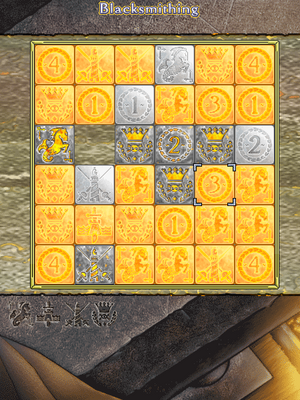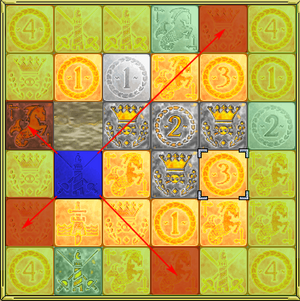Blacksmithing
| The subject of this article is undergoing testing and may be changed before implementation. | |
| Please see discussion on the talk page or check out the testing on the Ice Ocean. |
Blacksmithing is a crafting puzzle. It can be played in iron mongers. The puzzle is used to make swords and cannon balls.
Contents
[hide]Objective
The objective of the puzzle is to complete the board by striking each square three times. This is accomplished by following the movement tokens, either a number or a chess piece, on a square. When a square is struck three times, it is considered "complete" and may no longer be used. The crafting session is over either when all squares have been "completed" or when no move is available.
Movement Tokens
There are two sets of movement tokens in blacksmithing: numbers (1, 2, 3, 4) and chess pieces (Bishop, Rook, Queen, and Knight). They indicate what squares may be struck next. If the destination square is already "competed" or is beyond the border, then a move can not be made. The destination square, if available, is signified by a pulsating light. The Rum Jug probably is a wild card.
A number token indicates the distance between the original square and the destination square. For instance, if your last strike landed on a 2, then you may hit an available square that is exactly 2 squares away horizontally, vertically, or diagonally; a strike may not land on the square in between.
The chess pieces have the same movements as they do in chess: The Bishop moves diagonally; the Rook moves vertically or horizontally; the Knight moves in an "L" shape (2 x 1 squares or 1 x 2 squares); and the Queen moves diagonally, vertically, or horizontally. The difference of piece movement in blacksmithing as compared to original chess is that, with the exception of the Knight, the pieces always move to the border and cannot stop on any one of the squares in between. See the diagram to the right for a pictorial guide.
Progress Indicators
Blacksmithing has two types of progress indicators. The first one is overall completion indicator. Each square on the 6x6 board moves into different stages of completion each time it is struck. The color of the blade in the background gradually changes from red hot orange to smooth silver according to the overall percentage of square completion.
The second one is combo type and completion indicator. It is shown on the bottom left hand corner of the puzzle board. The combo type and completion is embossed onto the avil. This indicator reminds the player what type of movement tokens have been hit in the past few moves that may count toward a combo.
Gameplay
The player begins with a board of 36 red hot squares. The initial move may be made by clicking on any one square. Each square may be clicked on three times. On the first click, the square turns from bright orange to dark grey; on the second click, it turns silver; on the third click, the square disappears and is considered "complete." Which square may be clicked next is determined by the type of movement token discussed above. The movement token type changes randomly upon each click. The sequence continues until either all of the squares have been struck three times or there is no available move.
Scoring
Scoring is primarily based on the completion of the puzzle and combos. Completion means how many squares were left uncompleted at the end of the session. Fewer squares remaining will garner a higher score.
Combos may be set up in a variety of ways.
The first is matching identical indicators. For instance, starting on a 3 and moving to another 3 will be a double. If the player is then able to move to a third 3 it becomes a triple. If a fourth 3 is available it becomes a bingo then donkey, vegas etc... This method can be done with both numerical indicators and chess pieces.
The second combo is probably more difficult to achieve than the first one. This requires matching four of an indicator type, either numbers or chess pieces. For instance, if a player begins on a 2, moves to a 3, then a 1, and then a 4; they have completed a combo and receive a notification that they were "In the Rhythm". There is no particular order for this combo as long as all four numbers are included at the same time. Likewise with the four chess pieces, if a player manages to land on the four in any order consecutively, they will have completed the combo and receive a notification of "Fancy Hammerin'".
Once the puzzle is over either by completion or lack of moves, a message is given regarding the quality of the blade and usually is tied somewhat to the score of the session:
- "Maybe use that one as a club"
- "A hefty blade"
- "Finely balanced"
- "Keen edge"
- "A masterpiece!"
External/Other Links
- Commonly discussed ideas from Game Design
- Bia's announcement of the puzzle selected for "Blacksmithing"
| |
| See also: Labor |


